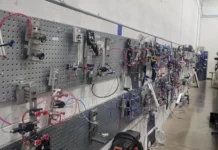by Doug Brewster, conveying product manager
Conair

The following hints and tips can help get things right if you choose to design and install a system yourself or when working with an equipment supplier.
How to get started
First, identify all of the materials that are processed in your plant and where each item comes from – refer to those silos, bins and gaylord boxes as “sources.” Keep in mind that blenders and dryers also may be considered sources if loaders are pulling material away from them.
Make a complete list for each machine (injection molder, extruder, blow molder, etc.) in the plant and identify them as “destinations.” In this context, the hopper of a dryer or the material bins on a blender are considered destinations, since the system will be delivering material to them.
Determine the maximum throughput rate (weight/hour) for each destination. The sum of these throughput rates, plus a factor for each 90° bend in the system and the horizontal and vertical distances that material must travel, will give an indication of the size of vacuum pump needed and optimal diameter of the conveying lines. Your equipment supplier can help perform these calculations and recommend the ideal pump(s) for each application.
In most cases, the line size will be dictated by the total throughput rate of all machines on that system pump. Remember to keep all conveying lines served by a given pump the same size, and make sure the line size matches properly with the horsepower of the pump. For instance, never put a large 15hp pump on a small 2-inch OD line. (The proper size for a 15hp pump is a 3-inch OD.) A rule of thumb to follow for pump horsepower and line sizes is as follows:
| If you have this pump | then use this line size |
| 5hp | 1.75- or 2-inch OD |
| 7.5hp | 2.25- or 2.5-inch OD |
| 10hp | 2.5-inch OD |
| 15hp | 3-inch OD |
| 25hp | 4-inch OD |
 Figure 1. The design of a material-conveying system requires a complete inventory of material sources and destinations, plus consideration of horizontal and vertical distances, number of 90° bends, required throughput rates and more.Pay attention to details. Vacuum loader inlet tubes should match the system piping. Make sure existing loader voltages match properly with the control system, and be sure the controller has the features you need or that features can be added in the future. It’s always much less costly to have features added at the factory rather than having technicians visit to download new programs and add input and output cards.
Figure 1. The design of a material-conveying system requires a complete inventory of material sources and destinations, plus consideration of horizontal and vertical distances, number of 90° bends, required throughput rates and more.Pay attention to details. Vacuum loader inlet tubes should match the system piping. Make sure existing loader voltages match properly with the control system, and be sure the controller has the features you need or that features can be added in the future. It’s always much less costly to have features added at the factory rather than having technicians visit to download new programs and add input and output cards.
Strategically locating the vacuum pump near the furthest machine (furthest from the source point) will have the effect of balancing the system. A short vacuum line should have a long material line and vice-versa. See Figure 1 as a guide.
System design

Keep material runs as straight as possible, and minimize the number of elbows. Every change in direction in a material-handling system increases back pressure and reduces conveying capacity. A vacuum pump of a given size can only do so much work, and it is important to make sure as much of that work as possible goes into moving material instead of overcoming system design flaws. The expensive alternative is to install a larger pump, but remember: Larger pumps usually require larger line sizes.
When laying out your system and sizing your pumps, make sure the conveying velocity at the material pick-up point (gaylord, storage bin or drying hopper) is kept as low as possible. Material will accelerate over the entire length of the run and, if it moves too fast, the material can degrade. Softer materials (such as polyethylene) can heat up and smear against the walls of the conveying lines, deforming and leaving “angel hair” behind to clog the system. Brittle materials (styrene or polycarbonate) can break up and create dust and fines that also clog the system. Abrasive materials (glass-filled ABS) actually can wear away the inside of the conveying lines, eventually causing leaks and failure. You may want to consider a variable-speed conveying system that can change conveying speed automatically to suit the characteristics of the specific resin being conveyed at a given moment.
Make sure the vacuum pump is sized for your location. Power systems that operate at 50Hz rather than the more conventional 60Hz can cause the vacuum pump to turn more slowly, actually derating it by about 17 percent. Use a bigger pump or one that turns at higher rpm to compensate. Also, don’t assume that a system specified for sea level will operate the same way at high altitude. The thinner air found at high altitudes has the same effect as lower electrical frequency. Because the air is less dense, you need to move more of it to achieve the same conveying capacity a system might have closer to sea level. Again, you’ll need a bigger or faster pump.
If purchasing new loaders, a fill sensor option installed in each loader can help avoid problems of overfilling or underfilling, which can occur when using timer control only. These devices can be invaluable in preventing equipment damage and keeping the conveying system running automatically.
Maintenance

Keep the filters clean. Your material-handling system is equipped with filters at two locations: one in the dust collector near the vacuum pump and the others in each vacuum receiver. A blinded filter has the same effect as too many elbows in a system design: Back pressure builds and the system loses conveying capacity. As the filters clog, youll notice that it takes longer to fill a vacuum receiver or, if the fill time is not changed, the receiver will not fill completely.
Locate and eliminate vacuum- and material-line leaks. Either one will diminish performance because the system will be sucking air rather than material. Again, you’ll notice sluggish conveying, longer fill times and, in the case of a material line leak, pellets on the floor. Leaks most often occur in flexible hoses and around couplings, seals and valves. They can usually be located via careful visual inspection. Sometimes, a hissing sound can be heard as air is pulled through a hole in the line. Smoke also can be used to locate a leak.
Pay attention to preventive maintenance on the vacuum pump. Follow the manufacturer’s recommendation for changing gear oil, and make sure all drive belts are tight and undamaged. It’s especially important to make sure the vacuum breaker valve is working properly. This valve is designed to break the system vacuum if it exceeds safe levels (about 15 inches of mercury) due to a clog in the line. If this happens, and a dirty valve fails to open, the pump will likely overheat and become damaged.
Operation
Make sure the system is set up properly at the beginning. Have the manufacturer’s service technician check overall system integrity and ensure all components are routed properly. All feed tubes should be properly set, and all receiver controls should have been programmed with appropriate load times and dump times.
Take care that the system always has material to convey. It sounds like a simple thing, but an empty gaylord or surge bin – or a feed tube that has become dislodged or clogged with a plastic box liner – will cause loader controls to alarm for lack of material. This can result in processing machine downtime and unscheduled maintenance. By making sure employees check material levels periodically, costly production disruptions can be avoided.
Operator training is critical – especially when employee turnover levels are high. Make sure everyone has the information they need to keep the system running. As above, a simple thing like allowing material to run out can be very disruptive. All employees should have a basic understanding of how the material-handling system operates and what their specific responsibilities are. If you don’t have the resources in-house, a system manufacturer usually will be able to perform this training.
Classroom training will cover such information as how the system is set up and how material is transported. On the plant floor, employees can learn how to operate the various components, how to log in to controls and make day-to-day adjustments, and how to change connections on a fantail manifold to source material from a different location or direct it to a different machine. Employees also need to understand various alarm conditions and know when there is a simple problem (the feed wand fell out of a gaylord, for instance) or something more complex (an electrical issue) that needs to be attended to by an electrician or service technician.
Even small-scale material-handling systems can be quite complex, requiring careful calculation of throughput, conveying distances, equipment specifications and more. Perhaps the most valuable tip of all is this: Take advantage of the knowledge, experience and advice of your equipment supplier. With their help, you can avoid many of the common problems that can arise in the design, installation, operation and maintenance of a material-handling system.
Doug Brewster is conveying product manager for the Conair Group and the primary developer of the R-PRO variable-speed conveying system. Brewster joined Conair in 1987 as a systems engineer. Since then, he has held a series of positions, including bulk-system product manager, project manager, national accounts manager, regional manager, national sales manager and customer service manager. In his current role, he has responsibility for continuous improvement in current equipment offerings and new product development. For more information, visit www.conairgroup.com.




